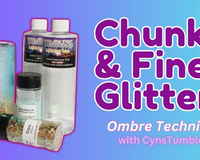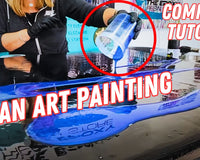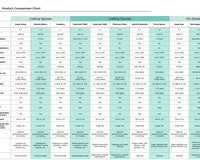Electronic grade potting epoxy resin is a specialized compound used to encapsulate and protect electronic components and circuits from moisture, chemicals, vibration, and other environmental hazards.
Potting typically involves filling the spaces around electronic components with the liquid epoxy resin, which then cures and hardens to form a solid protective barrier.
This shielding helps ensuring the long-term reliability and performance of sensitive electronics, especially in harsh conditions. Some other key benefits of using electronic grade potting epoxy include excellent electrical insulation, moisture resistance, mechanical strength, and thermal conductivity.
If you have ever opened up an electronic product and seen black stuff on top of a circuit board, that is likley this stuff.
What is Electronic Grade Potting Epoxy Resin?
Electronic grade potting epoxy resin is a specialized type of epoxy resin designed specifically for protecting and encapsulating electronic components and circuitry. Unlike regular epoxy resins, which are primarily used for adhesive or coating purposes, potting epoxy resins are formulated to provide superior insulation, moisture resistance, and mechanical protection for sensitive electronic equipment.
Difference from Regular Epoxy Resin
The main difference between regular epoxy resin and electronic grade potting epoxy resin lies in their composition and properties. Regular epoxy resins are typically designed for general-purpose applications, such as adhesives, coatings, or structural reinforcement. On the other hand, potting epoxy resins are specifically engineered to meet the demanding requirements of the electronics industry.
Properties for Circuit Protection
Electronic grade potting epoxy resin possess several key properties that make them ideal for circuit protection:
- Excellent electrical insulation: These resins have high dielectric strength, ensuring reliable insulation and preventing short circuits or electrical failures.
- Moisture resistance: They create a waterproof barrier, protecting sensitive components from moisture and humidity, which can cause corrosion or malfunction.
- Thermal stability: Potting epoxy resins can withstand a wide range of temperatures without degrading, making them suitable for use in harsh environments.
- Mechanical protection: They provide a rigid encapsulation that shields delicate circuitry from physical impacts, vibrations, and other mechanical stresses.
Types of Electronic Grade Potting Epoxy Resins
There are several different types of electronic grade potting epoxy resins available in the market, each with its own unique properties and applications:
- Rigid potting resins: These resins cure to form a hard, rigid encapsulation, offering excellent mechanical protection for components and circuits.
- Flexible potting resins: These resins maintain a degree of flexibility after curing, making them suitable for applications where some movement or vibration is expected.
- Thermally conductive potting resins: These resins have enhanced thermal conductivity, allowing for efficient heat dissipation from electronic components, preventing overheating.
- Optically clear potting resins: These transparent resins are used for encapsulating light-emitting components or sensors, allowing light to pass through without interference.
The specific type of Electronic grade potting epoxy resin chosen depends on the application requirements, such as the operating environment, the size and complexity of the components being encapsulated, and the desired level of protection.
Benefits of Using Electronic Grade Potting Epoxy Resin
Unmatched Protection for Your Circuitry
When it comes to safeguarding your sensitive electronic components and circuit boards, nothing beats the superior protection offered by electronic grade potting epoxy resin. This specialized compound is designed to create a robust barrier against moisture, chemicals, and physical impact, ensuring the longevity and reliable performance of your electronics.
Moisture Resistance: Water exposure can be devastating for delicate circuitry, leading to corrosion, short circuits, and complete failure. Potting epoxy resin forms a waterproof seal around your components, shielding them from humidity, condensation, and accidental spills.
Electrical Insulation: With its excellent dielectric properties, electronic grade potting epoxy provides superior insulation, preventing electrical shorts and minimizing interference. This ensures your circuits function optimally, free from disruptions caused by stray currents or electromagnetic fields.
Mechanical Strength: The cured resin encapsulates your components, creating a rigid and shock-resistant structure. This added mechanical strength safeguards against vibrations, impacts, and other physical stresses, making it ideal for use in harsh environments or demanding applications.
Real-World Applications: Where Potting Epoxy Resin Shines
The versatility and reliability of Electronic grade potting epoxy resin make it an essential choice across numerous industries and applications:
Automotive Electronics: From engine control units to sensors and infotainment systems, potting compounds protect critical automotive electronics from the rigors of the road, ensuring optimal performance and safety.
Aerospace Components: The extreme conditions encountered in aerospace applications demand the utmost protection. Potting epoxy resin is trusted to safeguard avionics, navigation systems, and other vital aerospace electronics.
Medical Devices: In the healthcare industry, where reliability is paramount, potting compounds are used to encapsulate implantable devices, diagnostic equipment, and other sensitive medical electronics, ensuring their continued functionality and patient safety.
Whether you're a hobbyist, an engineer, or a manufacturer, investing in electronic grade potting epoxy resin is a surefire way to extend the lifespan and enhance the performance of your electronic creations, giving you the peace of mind that your circuits are well-protected against the elements.
How to Choose the Right Electronic Grade Potting Epoxy Resin
When it comes to protecting delicate electronic components and circuitry from environmental factors like moisture, dust, and vibration, choosing the right electronic grade potting epoxy resin is crucial. This specialized compound is designed to encapsulate and safeguard sensitive electronics, ensuring reliable performance and extended lifespan.

Evaluating Viscosity and Cure Time
One of the key considerations when selecting an epoxy potting resin is its viscosity. A low viscosity resin can easily penetrate tight spaces and intricate circuit designs, while a higher viscosity may be better suited for larger components or potting encapsulation projects. Additionally, the cure time plays a significant role in determining the appropriate resin for your application. Some resins cure rapidly, allowing for quick turnaround times, while others require longer curing periods for optimal strength and adhesion.
Thermal Conductivity and Compatibility
Another important factor to consider is thermal conductivity. Many electronic devices generate heat during operation, and a potting resin with good thermal conductivity can help dissipate this heat, preventing overheating and potential damage. Furthermore, it's essential to ensure that the potting epoxy is compatible with the materials used in your electronic components, such as plastics, metals, and coatings, to avoid any adverse reactions or degradation.
Key Considerations for Successful Potting
Proper surface preparation is crucial for successful potting. Ensure that the surfaces are clean, dry, and free from contaminants like grease or oil, as these can interfere with the adhesion of the resin. Additionally, follow the manufacturer's instructions carefully regarding the mixing ratio and curing conditions, as deviations can affect the final properties of the cured resin.
When working with potting epoxy resins, it's essential to take appropriate safety precautions. Wear gloves, work in a well-ventilated area, and follow the manufacturer's guidelines for handling and disposal.
By considering factors like viscosity, cure time, thermal conductivity, and compatibility, you can choose the right electronic grade potting epoxy resin for your specific application, ensuring optimal protection and performance for your electronic devices.
Step-by-Step Guide to Potting Electronic Components
Preparing for the Potting Process
Before you begin potting your electronic components, it's crucial to gather all the necessary tools and materials. You'll need electronic grade potting epoxy resin, a mixing container, a stir stick, and protective gear like gloves and safety glasses. Ensure your work area is well-ventilated and free from dust or debris.
Step-by-Step Instructions
- Safety First: Always wear gloves and safety glasses when working with potting epoxy resin. The fumes can be harmful, and the resin can cause skin irritation.
- Mixing the Resin: Carefully measure and mix the epoxy resin and hardener according to the manufacturer's instructions. Improper mixing can result in an incomplete cure or compromised electronic protection.
- Preparing the Components: Clean the electronic components thoroughly to remove any dirt, grease, or contaminants. This will ensure proper adhesion of the potting compound.
- Applying the Resin: Slowly pour the mixed potting epoxy resin over the electronic components, ensuring complete coverage. Use a stir stick to gently work the resin into any crevices or hard-to-reach areas.
- Eliminating Air Bubbles: Tap the container gently to release any trapped air bubbles. Air bubbles can weaken the potting encapsulation and compromise the electronic protection.
- Curing Process: Allow the potted components to cure according to the manufacturer's recommendations. Proper curing temperature and time are crucial for achieving the desired strength and durability.
- Finishing Touches: Once the potting resin has fully cured, you can trim or sand any excess material for a clean, professional finish.
Common Mistakes to Avoid
- Improper Mixing: Inaccurate measuring or incomplete mixing of the epoxy resin and hardener can lead to poor curing and compromised electronic protection.
- Air Entrapment: Failing to release trapped air bubbles can create weak spots in the potting encapsulation, leaving your electronic components vulnerable.
- Incorrect Curing Temperature: Deviating from the recommended curing temperature can affect the curing process, resulting in a weaker or brittle potting compound.
By following these steps and avoiding common mistakes, you can achieve optimal results when potting your electronic components with electronic grade potting epoxy resin. Proper potting encapsulation not only protects your circuitry from environmental factors but also enhances the overall durability and longevity of your electronic equipment.
Maintaining and Troubleshooting Potted Electronic Components
Ensuring Long-Term Performance with Proper Maintenance
Potted electronic components, encapsulated with epoxy resin or other potting compounds, require regular maintenance to ensure optimal performance and longevity. One crucial step is inspecting the potting material for cracks, chips, or signs of degradation, as these can compromise the protection of the internal circuitry. Additionally, keeping the potted components clean and free from dust, moisture, and other contaminants is essential to prevent potential issues.
Troubleshooting Common Issues
Despite proper maintenance, potted electronic components may encounter problems over time. If you notice any malfunctions or performance issues, it's essential to troubleshoot the problem promptly. One common issue is delamination, where the potting compound separates from the encapsulated components or the housing. This can lead to ingress of moisture, dust, or other contaminants, potentially causing short circuits or corrosion.
Another potential problem is overheating, which can occur due to inadequate heat dissipation or faulty components within the potted assembly. Overheating can cause the potting material to become brittle or even melt, leading to further damage to the internal components.
When to Remove Potting Material
In some cases, it may be necessary to remove the potting material for repairs or replacements. This process, known as depotting, should be undertaken with caution and proper safety precautions, as it can be challenging and potentially hazardous.
One scenario where depotting may be required is when a specific component within the potted assembly needs to be replaced or repaired. In such cases, carefully removing the potting compound can provide access to the faulty component without damaging the surrounding circuitry.
Another situation where depotting may be necessary is when the potted assembly has sustained significant damage, and the internal components need to be inspected or replaced. However, it's important to note that depotting should only be attempted by trained professionals or under the guidance of experienced technicians, as improper handling can lead to further damage or safety risks.
By following these guidelines for maintaining and troubleshooting potted electronic components, you can ensure their optimal performance and extend their lifespan, while also addressing any issues that may arise in a safe and effective manner.
Frequently Asked Questions about Electronic Grade Potting Epoxy Resin
Understanding the Shelf Life and Storage Conditions
One of the most common questions regarding Electronic grade potting epoxy resin is its shelf life and proper storage conditions. These potting compounds are designed to protect delicate circuitry and electronic components from environmental factors like moisture, vibration, and shock. Proper storage is crucial to ensure the epoxy resin maintains its integrity and performance.
The typical shelf life for an electronic grade potting epoxy ranges from 12 to 24 months, depending on the manufacturer and specific formulation. However, it's essential to follow the recommended storage conditions to maximize its shelf life. Most potting resins should be stored in a cool, dry place, away from direct sunlight and extreme temperatures.
Safe Disposal Methods for Potting Compounds
Another frequent concern among users is the safe disposal of potting epoxy resins after use. These compounds are typically considered non-hazardous waste, but it's essential to follow proper disposal methods to minimize environmental impact.
Once the potting compound has cured, it can be disposed of with regular solid waste. However, if the epoxy is still in its liquid form, it should be treated as hazardous waste and disposed of accordingly. Many municipalities have specific guidelines for the disposal of liquid epoxy resins, so it's crucial to check with your local authorities for proper procedures.
For larger quantities or industrial applications, it's recommended to work with a licensed waste disposal company that specializes in handling potting compounds and other industrial materials.
Tips for Successful Potting Projects
To ensure a successful potting project, it's essential to follow the manufacturer's instructions carefully. This includes proper surface preparation, mixing ratios, and curing times. Additionally, it's recommended to work in a well-ventilated area and wear appropriate personal protective equipment, such as gloves and safety glasses.
When potting electronics, it's crucial to ensure that all components are securely in place and that there are no air pockets or voids in the potting compound. This can be achieved by using techniques like vacuum degassing or carefully pouring the epoxy resin to minimize air entrapment.
Remember, electronic grade potting epoxy resins are designed to provide long-lasting protection for sensitive circuitry and components. By following best practices and addressing common concerns, you can ensure a successful potting project and extend the lifespan of your electronics.
Reliable Protection for Your Electronic Marvels
As a passionate DIY crafter or artist working with epoxy resin, you understand the importance of safeguarding your electronic components from environmental hazards. Electronic grade potting epoxy resin offers a reliable solution, ensuring long-lasting performance and durability for your electronic creations.
Whether you're embarking on a new project or seeking guidance on potting techniques, our team at The Epoxy Resin Store is here to assist you.
Call us at (951)-677-0400 during business hours, and let's explore how we can help you achieve flawless circuit protection with the right potting compound.
👉👉 If you liked this article and want to see more
👉👉 Comment "Epoxy Resin Tutorial" because that does two things.
1. It lets us know you like it, and encourages our creators!
2. Commenting gives you a chance to win within one of our upcoming givesaways. -hint-hint
https://www.theepoxyresinstore.com/ is an expert manufacturer of various epoxy resins that can be used for both craft projects and industrial applications. We also offer liquid inks, dyes, pigments, glitter, other additives, and tools for various epoxy resin projects.
The Epoxy Resin Store
support@theepoxyresinstore.com
Phone: (951) 677-0400
Address: 540 Crane St suite A Lake Elsinore, CA 92530
https://www.theepoxyresinstore.com
Social Accounts:
https://www.facebook.com/TheEpoxyResinStore
https://twitter.com/epoxyresinstore
https://www.linkedin.com/company/the-epoxy-resin-store
https://www.youtube.com/channel/UC3NKcCrYL5uHK-sH5XMQ9HA
https://instagram.com/theepoxyresinstore
#epoxy #epoxyresin #theepoxyresinstore
















